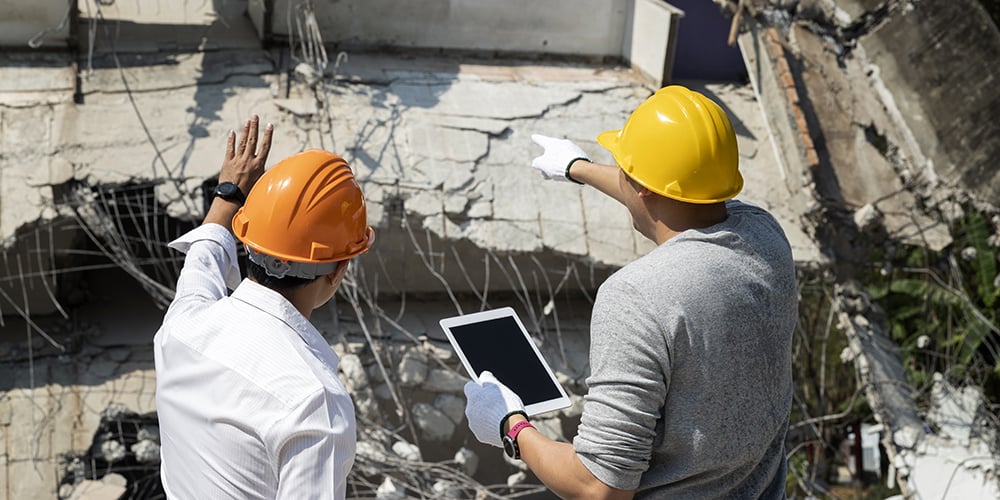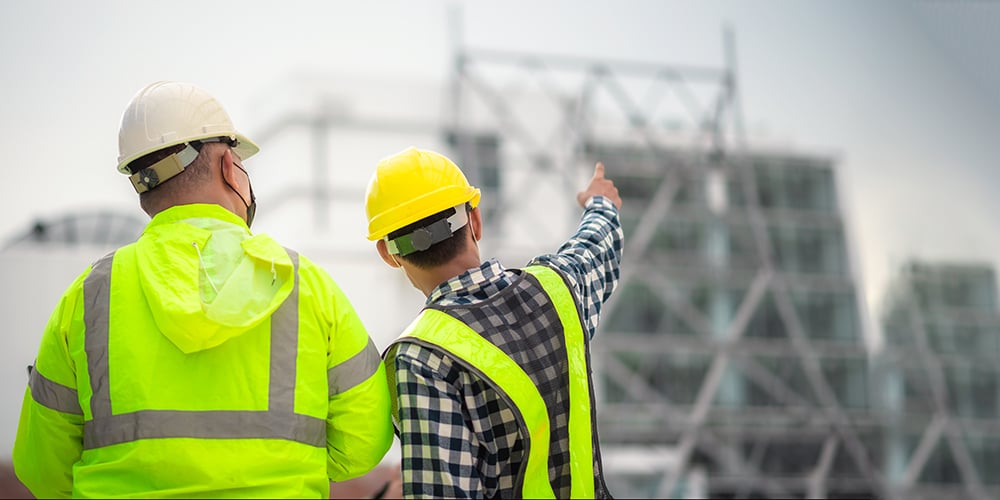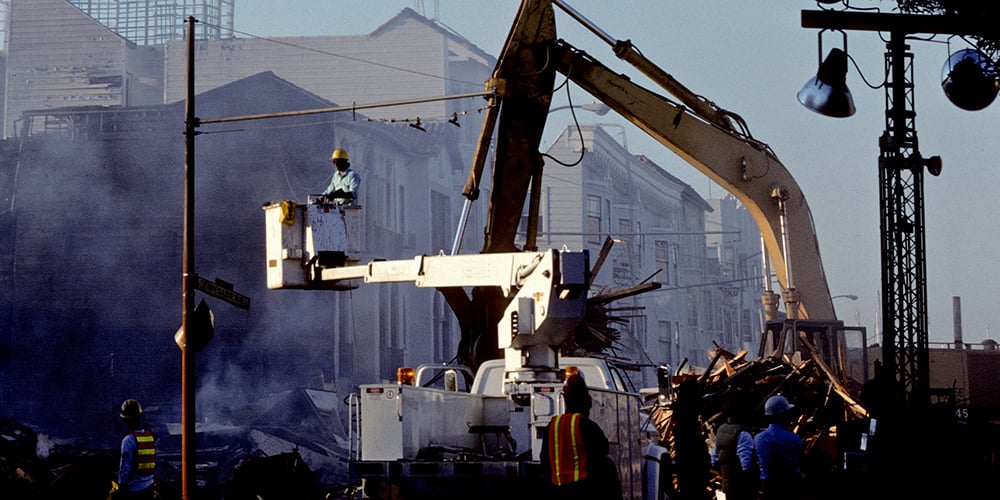An earthquake has struck. It’s time to act.
Climate and EnergyArticleFebruary 17, 2022
Until science can develop ways to anticipate the timing of potential earthquakes with anything like the accuracy meteorologists can achieve when predicting severe weather, quakes will continue to occur without warning. And during the first critical seconds and minutes of a serious earthquake, no priority is greater than the safety and well-being of your employees and others in and around your facility.
While earthquakes have at one time or another affected numerous geographic regions across North America, including Midwestern states more accustomed to severe convective storms, western states bordering the Pacific “Ring of Fire” are clearly at greatest risk.
Most serious injuries during the initial moments of an earthquake are caused by falling or flying objects and debris, or tip-overs of heavy objects such as bookshelves, production equipment, or stock and supplies. Injury potential may be amplified by the fact that most of us are likely to respond to the initial shocks with a moment of hesitation, then panic. But during an earthquake, any hesitation can be a prescription for disaster.
Actions to take during an earthquake
In addition to its primary role focusing on infectious disease, the U.S. Centers for Disease Control (CDC) provides information about a variety of other risks to health and safety, including earthquakes. Some of the agency’s recommendations regarding actions to take during an active quake include: 1
- Drop down onto your hands and knees to prevent the earthquake from knocking you down. This position can help protect you from falling objects while still allowing movement to shelter, if necessary.
- Cover your head and neck — and your entire body if possible — under sturdy, low-lying furniture that will not fall, such as a desk or workstation. If there is no shelter nearby, move to an interior wall while continuing to cover your head and neck with your arms and hands.
- QUICKLY MOVE AWAY from glass, hanging objects or large, free-standing furniture or equipment. Watch for falling objects, such as light fixtures, wall hangings, high shelves, and cabinets with doors that could swing open.
- Hold onto your shelter and continue covering your head and neck until the shaking stops.
- Do not run outside or to other rooms. You are less likely to be injured if you stay where you are.
- Do not use elevators. Loss of power is a frequent consequence of an earthquake, which could result in entrapment.
- Do not stand in a doorway. Contrary to popular perception, doorways are not necessarily the safest places to ride out an earthquake. The most likely causes of injury during an earthquake are falling or flying objects. You are safer under a strong desk, table or workstation.
- If you are outside, stay outside. Move to open areas where there are no utility poles, overhead lines or trees. Move away from outside walls of any buildings, which are often the most dangerous places to be in the event of falling debris. Once you have found a safe, open location, remain there until the shaking stops.
Coping with the immediate aftermath of an earthquake
Keep in mind that many injuries occur after an earthquake. In addition, aftershocks following the main quake can amplify the risks of additional damage to unstable structures and the potential for injuries. The following are some immediate earthquake survival recommendations to consider in the hours after a quake:2
- Check yourself and others for injuries. Provide first aid for anyone who needs it.
- Follow your organization’s emergency plan and the instructions of persons in charge.
- Check water, gas, and electric lines for damage. If any are damaged, shut off the valves.
- Check for the smell of gas. If you smell it, open all the windows and doors, leave immediately, and report it to the authorities.
- Turn on the radio. Try not to use your phone unless it's an emergency. Local cellphone capacity will be maxed out.
- Stay out of damaged buildings.
- Be careful around broken glass and debris. Wear boots or sturdy shoes.
- Be careful of chimneys; they may be structurally weakened and may fall.
- Expect aftershocks.
Fires following earthquakes are a frequent risk
As if the potential for physical damage and mass casualties due to a major earthquake was not bad enough, fires following a seismic event can be the most devastating secondary effects of a quake. The conflagration following the devastating 1906 San Francisco Earthquake resulted in the largest urban fire in U.S. history, dwarfing even the Great Chicago Fire 35 years earlier.
Be aware of the following fire risk factors in the aftermath of a major earthquake3:
- Systems containing flammable and combustible liquids and gases may be damaged by seismic shaking or the failure of other utility systems or building features. The damage may allow spills or leaks that may ignite. Hazardous chemical interactions in industrial facilities may occur that lead to fires.
- Automatic fire protection systems may be damaged by the seismic shaking or the failure of other utility systems or building features upon which fire protection systems depend. Such damage may impair fire protection when it is needed most.
- Automatic fire detection systems depend upon the public telephone network to transmit alarm signals and promptly notify the public fire service. Damage to telephone lines, high demand for the available telephone service, and excessive signal being received by the public fire service may compromise the effectiveness of alarm signal delivery or the action on any signal that is received.
- The public fire service may be severely overtaxed by an earthquake event. It is anticipated that normal response practices will quickly transition to emergency response protocols. All requests for emergency aid will be prioritized with resources directed to life safety concerns first.
- Normal routes of travel for the responding public fire service may be obstructed by debris, fallen power lines, damaged bridges and overpasses and other impediments. Response may be significantly delayed or impossible.
- Water mains may experience breaks that reduce available water pressure, flow and capacity, or which render water service completely interrupted. Fire systems such as automatic sprinklers may have no water supply, and once the public fire service arrives, they may find public fire hydrants impaired as well.
- Fire-rated construction that would normally provide fire confinement or protection from neighbors may be compromised by the earthquake such that fire can readily spread past damaged fire wall or inoperative fire doors.
Earthquakes are truly among the most fear-inducing, disruptive natural phenomena we face, due both to their unpredictability and their potential for widescale damage and injuries. How you and your team respond during the event and in the immediate hours and days afterward will have a major impact on the success of your earthquake recovery plan in the weeks and months ahead.
These response actions should be part of a fully developed earthquake Emergency Response Plan (ERP). The articles below detail the other major components of an effective plan: mitigation/ preparedness and recovery. We also offer an article with background to consider before developing your earthquake ERP. Taken together, they can provide your business with a path to reduced risks and faster recovery.
The guidance in this article was provided by the Zurich Resilience Solutions’ (ZRS) Risk Engineering team.
1. “Stay Safe During an Earthquake.” Centers for Disease Control and Prevention. 24 September 2020.
2. “What Should I Do Before, During and After an Earthquake.” Michigan Technological University. 2022.
3. Scawthorn, Charles; Eidinger, John M.; Schiff, Anshel J. Schiff. “Fire Following Earthquake.” Technical Council on Lifeline Earthquake Engineering (TCLEE) Monograph 26. American Society of Civil Engineers. 2005.
The information in this publication was compiled from sources believed to be reliable for informational purposes only. All sample policies and procedures herein should serve as a guideline, which you can use to create your own policies and procedures. We trust that you will customize these samples to reflect your own operations and believe that these samples may serve as a helpful platform for this endeavor. Any and all information contained herein is not intended to constitute advice (particularly not legal advice). Accordingly, persons requiring advice should consult independent advisors when developing programs and policies. We do not guarantee the accuracy of this information or any results and further assume no liability in connection with this publication and sample policies and procedures, including any information, methods or safety suggestions contained herein. We undertake no obligation to publicly update or revise any of this information, whether to reflect new information, future developments, events or circumstances or otherwise. Moreover, Zurich reminds you that this cannot be assumed to contain every acceptable safety and compliance procedure or that additional procedures might not be appropriate under the circumstances. The subject matter of this publication is not tied to any specific insurance product nor will adopting these policies and procedures ensure coverage under any insurance policy.



